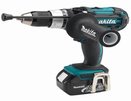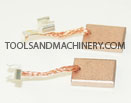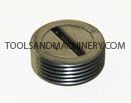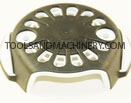 Because we all know that most of our drills, even the Makita models, will require a brush replacement procedure at some point, or at many points, in its life, and because we all also know that performing said brush replacement procedure is relatively simple when given the right steps, I’ll simply cut to the chase and provide those steps without pulling any punches.
Because we all know that most of our drills, even the Makita models, will require a brush replacement procedure at some point, or at many points, in its life, and because we all also know that performing said brush replacement procedure is relatively simple when given the right steps, I’ll simply cut to the chase and provide those steps without pulling any punches.
But first, (ouch! Punch pulled) I’ll lay down the preliminaries, three to be exact. First, read your tool manual. If you don’t have a manual, request one from Makita or from a dealer, or download one online. Contrary to some opinions, your drill manual is a valuable resource and will contain specific information about that impending brush replacement. Second, make certain you have the correct Makita brushes for your specific drill
. Just as no drill is exactly the same, no brush is either. Lastly, make sure that to tool is entirely disengaged
, deactivated, disconnected, and otherwise completely off.
 Now, the chase begins with getting to your brushes. Most Makita drills will offer very simple access to the brushes. Unless your model is of the older variety, you
Now, the chase begins with getting to your brushes. Most Makita drills will offer very simple access to the brushes. Unless your model is of the older variety, you
 will have either a rear cover or brush caps. An rear cover (pictured in lower right) is a dome-shaped piece of the drill housing at the very rear of the drill that can be removed without completely disassembling the housing. Simply unscrew the rear cover to reach the brushes. Brush caps (pictured in upper right) will be on either side of the drill, also near its rear. They are, again, small pieces of the housing (about one square inch in size (give or take) that
will have either a rear cover or brush caps. An rear cover (pictured in lower right) is a dome-shaped piece of the drill housing at the very rear of the drill that can be removed without completely disassembling the housing. Simply unscrew the rear cover to reach the brushes. Brush caps (pictured in upper right) will be on either side of the drill, also near its rear. They are, again, small pieces of the housing (about one square inch in size (give or take) that
 are usually black in color (or some shade different from the whole of the housing)) that when removed will take you straight to the brushes. If you don’t have brush caps or a rear cover on your drill, you will need to open-up the drill’s housing or clamshell. Keep in mind when removing anything from the tool though, that you will soon have to replace it; keeping organized is very important for reassembly. After removing the top half of the housing, the brushes should be located at the at the back of the motor in the rear of the drill.
are usually black in color (or some shade different from the whole of the housing)) that when removed will take you straight to the brushes. If you don’t have brush caps or a rear cover on your drill, you will need to open-up the drill’s housing or clamshell. Keep in mind when removing anything from the tool though, that you will soon have to replace it; keeping organized is very important for reassembly. After removing the top half of the housing, the brushes should be located at the at the back of the motor in the rear of the drill.
The brushes will be tucked into a guide sleeve. Remove them from the guide sleeve and replace the new ones in exactly the same fashion as the others were removed. Make sure that your brushes are making complete contact with the armature and the chase is pretty well finished. Carefully put the drill back together and re-engage it for the final step of the procedure. Test all the functions of the drill
; run it in forward and reverse, change the gears if you have the capability, drive a screw or drill a hole and make sure all has come back together properly. If all checks out, then you have successfully replaced your brushes. If all hasn’t checked, make sure you haven’t simply made an easy mistake. If no mistakes crawl out of the woodwork, then you should take the drill to an authorized Makita service center for a complete diagnosis.













